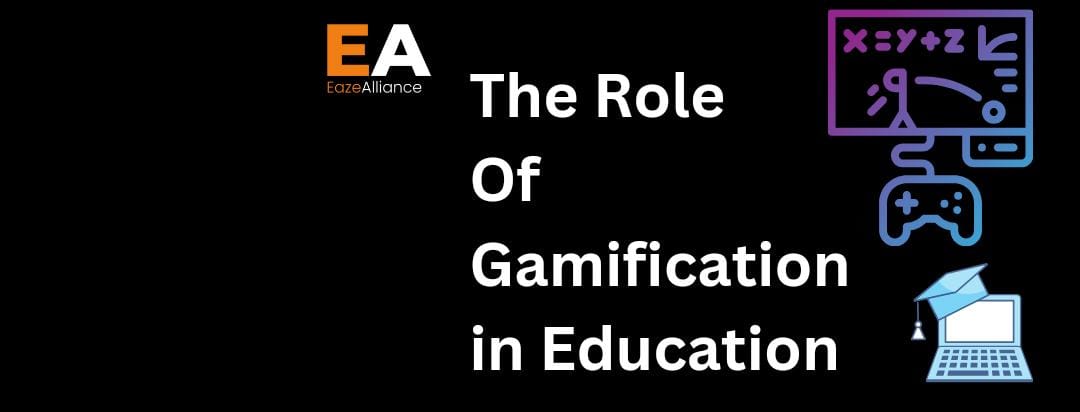The Role of Gamification in Education: Making Learning Engaging and Effective
 Eazealliance
Eazealliance 
In an era where traditional educational methods often struggle to captivate students’ attention, gamification has emerged as a powerful tool to enhance learning experiences. By incorporating game-like elements into educational settings, gamification aims to make learning more engaging, motivating, and effective. This article by EazeAlliance explores how gamification is transforming education, its benefits, challenges, and strategies for successful implementation.
Understanding Gamification in Education
Gamification involves applying game design principles and mechanics to non-game contexts to encourage engagement and motivation. In education, this means integrating elements such as points, badges, leaderboards, challenges, and rewards into the learning process. The goal is to create an interactive and stimulating environment that fosters deeper learning and keeps students motivated.
Benefits of Gamification in Education
Increased Engagement and Motivation
One of the most significant advantages of gamification is its ability to boost student engagement and motivation. Game-like elements, such as earning points and achieving milestones, can make learning more enjoyable and compelling. This heightened engagement often leads to increased participation and a greater willingness to tackle challenging material.
Enhanced Learning Retention
Gamification can improve learning retention by making educational content more memorable and interactive. Through simulations, role-playing, and interactive quizzes, students can engage with the material in a hands-on manner. This active involvement helps reinforce concepts and improve long-term retention of knowledge.
Immediate Feedback and Rewards
Games provide instant feedback, allowing players to understand their progress and areas for improvement. Similarly, gamified learning environments offer immediate feedback on performance through scores and progress indicators. This real-time feedback helps students identify their strengths and weaknesses, fostering a growth mindset and encouraging continuous improvement.
Encouraging Collaboration and Competition
Gamification can promote collaboration and healthy competition among students. Collaborative challenges and team-based activities encourage students to work together and share knowledge, while leaderboards and competitions can stimulate a friendly rivalry that drives motivation. This social aspect of gamification can enhance peer learning and build a sense of community in the classroom.
Personalized Learning Experiences
Gamified learning platforms often allow for personalized learning paths, adapting to individual students’ needs and abilities. By tailoring challenges and rewards to each student’s progress, gamification can provide a more customized learning experience that meets diverse needs and learning styles.
Challenges and Considerations
While gamification offers numerous benefits, it also presents several challenges that educators need to address:
Overemphasis on Rewards
There is a risk that students may become overly focused on rewards and extrinsic motivation, rather than the intrinsic value of learning. To mitigate this, it’s essential to balance rewards with meaningful learning experiences and ensure that gamification elements support educational goals rather than overshadow them.
Equity and Access
Not all students have equal access to the technology required for gamified learning, which can create disparities in educational opportunities. Educators should consider these factors and strive to implement gamification strategies that are inclusive and accessible to all students.
Balancing Fun with Learning Objectives
It’s important to ensure that gamification does not compromise the educational content. Games should be designed to align with learning objectives and enhance, rather than distract from, the educational experience. Careful planning and integration are necessary to strike the right balance.
Design and Implementation
Designing and implementing effective gamification strategies requires time and resources. Educators need to invest in creating well-structured games and activities that align with curricular goals. Additionally, ongoing assessment and refinement are crucial to ensure that gamification strategies remain effective and relevant.
Strategies for Successful Implementation
Align Gamification with Learning Goals
Ensure that gamified elements are closely aligned with the educational objectives. Design games and challenges that reinforce key concepts and skills, and use rewards and feedback to support the learning process.
Incorporate Student Input
Involve students in the design process to create gamification elements that resonate with their interests and preferences. Gathering feedback from students can help tailor the experience to their needs and increase engagement.
Use a Variety of Game Mechanics
Employ a range of game mechanics to cater to different learning styles and preferences. Incorporate elements such as storytelling, role-playing, and problem-solving challenges to create a diverse and engaging learning environment.
Monitor and Evaluate Effectiveness
Regularly assess the impact of gamification on student learning and engagement. Use data and feedback to evaluate the effectiveness of gamified elements and make necessary adjustments to improve the learning experience.
Conclusion
Gamification is revolutionizing education by making learning more engaging, interactive, and effective. By incorporating game-like elements, educators can enhance student motivation, improve retention, and foster collaboration. However, successful implementation requires careful planning, alignment with educational goals, and ongoing evaluation. As gamification continues to evolve, it holds the potential to transform traditional educational practices and create dynamic and impactful learning experiences.
EazeAlliance is committed to exploring innovative approaches to education and sharing insights on how emerging technologies and strategies can enhance learning. Gamification represents a significant advancement in this journey, offering exciting opportunities for educators and students alike.
Subscribe to my newsletter
Read articles from Eazealliance directly inside your inbox. Subscribe to the newsletter, and don't miss out.
Written by

Eazealliance
Eazealliance
We accelerate your sales cycle while teaching you how easily you can create relationship where clients love to buy from you.